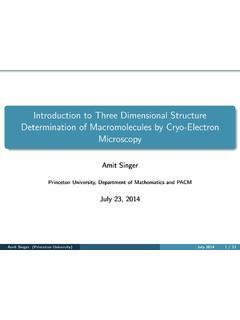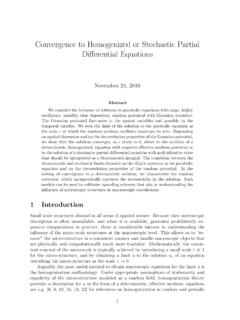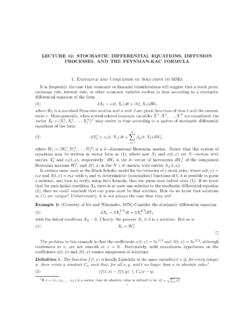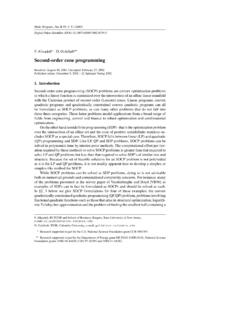Transcription of LECTURE 12: STOCHASTIC DIFFERENTIAL EQUATIONS, …
1 LECTURE 12: STOCHASTIC DIFFERENTIAL EQUATIONS, DIFFUSION. PROCESSES, AND THE FEYNMAN-KAC FORMULA. 1. Existence and Uniqueness of Solutions to SDEs It is frequently the case that economic or financial considerations will suggest that a stock price, exchange rate, interest rate, or other economic variable evolves in time according to a STOCHASTIC DIFFERENTIAL equation of the form (1) dXt = (t, Xt ) dt + (t, Xt ) dWt where Wt is a standard Brownian motion and and are given functions of time t and the current state x. More generally, when several related economic variables X 1 , X 2.
2 , X N are considered, the vector Xt = (Xt1 , Xt2 , .. , XtN )T may evolve in time according to a system of STOCHASTIC DIFFERENTIAL equations of the form d ij (t, Xt ) dWtj , X. (2) dXti = i (t, Xt ) dt +. j=1. where Wt = (Wt1 , Wt2 , .. , Wtd ) is a d dimensional Brownian motion. Notice that this system of equations may be written in vector form as (1), where now X t and (t, x) are N vectors with entries Xti and i (t, x), respectively; dWt is the d vector of increments dWtj of the component Brownian motions Wtj ; and (t, x) is the N d matrix with entries ij (t, x).
3 In certain cases, such as the Black-Scholes model for the behavior of a stock price, where (t, x) =. rt x and (t, x) = t x with rt and t deterministic (nonrandom) functions of t, it is possible to guess a solution, and then to verify, using Ito 's formula, that the guess does indeed obey (1). If we knew that for each initial condition X0 there is at most one solution to the STOCHASTIC DIFFERENTIAL equation (1), then we could conclude that our guess must be that solution. How do we know that solutions to (1) are unique? Unfortunately, it is not always the case that they are!
4 Example 1: (Courtesy of Ito and Watanabe, 1978) Consider the STOCHASTIC DIFFERENTIAL equation 1/3 2/3. (3) dXt = 3Xt dt + 3Xt dWt with the initial condition X0 = 0. Clearly, the process Xt 0 is a solution. But so is (4) Xt = Wt3 .. The problem in this example is that the coefficients (t, x) = 3x 1/3 and (t, x) = 3x2/3 , although continuous in x, are not smooth at x = 0. Fortunately, mild smoothness hypotheses on the coefficients (t, x) and (t, x) ensure uniqueness of solutions. Definition 1. The function f (t, x) is locally Lipschitz in the space variable(s) x if, for every integer n, there exists a constant Cn such that, for all x, y, and t no larger than n in absolute value 1, (5) |f (t, x) f (t, y)| Cn |x y|.
5 1If x = (x , x , .. , x ) is a vector, then its absolute value is defined to be |x| =. pP. 1 2 n i x2i . 1. In practice, one rarely needs to verify this condition, because the following is true, by the mean value theorem of calculus: If f (t, x) is continuously differentiable, then it locally Lipschitz. Occasionally one encounters situations where one of the coefficients in a STOCHASTIC DIFFERENTIAL equation has corners (for instance, the function f (x) = |x|); such functions are locally Lipschitz but not continuously differentiable. Theorem 1. Suppose that the functions i (t, x) and ij (t, x) are all locally Lipschitz in the space variable x.
6 Then for each initial condition X 0 = x0 , there is at most one solution to the system of STOCHASTIC DIFFERENTIAL equations (2). Are there always solutions to STOCHASTIC DIFFERENTIAL equations of the form (1)? No! In fact, existence of solutions for all time t 0 is not guaranteed even for ordinary DIFFERENTIAL equations (that is, DIFFERENTIAL equations with no random terms). It is important to understand why this is so. A DIFFERENTIAL equation (or a system of DIFFERENTIAL equations) prescribes how the state vector Xt will evolve in any small time interval dt, for as long as the state vector remains finite.
7 However, there is no reason why the state vector must remain finite for all times t 0. Example 2: Consider the ordinary DIFFERENTIAL equation dx 1. (6) = for 0 t < 1. dt 1 t The solution for the initial condition x 0 is Z t (7) x(t) = x0 + (1 s) 1 ds = x0 log(1 t) for 0 t < 1. 0. As t approaches 1, x(t) converges to .. Example 3: The previous example shows that if the coefficients in a DIFFERENTIAL equation depend explicitly on t then solutions may explode in finite time. This example shows that explosion of solutions may occur even if the DIFFERENTIAL equation is autonomous, that is, if the coefficients have no explicit time dependence.
8 The DIFFERENTIAL equation is dx (8) = x2 . dt The general solution is (9) x(t) = (t C) 1 . For the initial condition x(0) = x0 > 0, the value of C must be C = 1/x0 . Consequently, the solution x(t) explodes as t approaches 1/x 0 .. Observe that in Example 2, the coefficient (t, x) = x 2 is not only time-independent, but con- tinuously differentiable, and therefore locally Lipschitz. Hence, the hypotheses of Theorem 1 do not guarantee existence of solutions for all t. The next theorem gives useful sufficient conditions for the existence of solutions for all t. Theorem 2.
9 Assume that the coefficients in the system (1) of STOCHASTIC DIFFERENTIAL equations satisfy the following global Lipschitz and growth conditions: for some C < , (10) | i (t, x) i (t, y)| C|x y| for all t R and x, y R N. | ij (t, x) ij (t, y)| C|x y| for all t R and x, y R N. | i (t, x)| C|x| for all t R and x RN , and | ij (t, x)| C|x| for all t R and x RN . Then for each x0 RN there is a (unique) solution to the system (1) such that X 0 = x0 . The existence and uniqueness theorems 1 and 2 stated above were proved by Ito in 1951. The proofs follow the lines of the classical proofs for existence and uniqueness of solutions of ordinary DIFFERENTIAL equations, with appropriate modifications for the random terms.
10 See, for instance, Karatzas & Shreve for details. More properties of the Ornstein-Uhlenbeck process are given in the exercises. 2. The Ornstein-Uhlenbeck Process In the parlance of professional probability, a diffusion process is a continuous-time STOCHASTIC process that satisfies an autonomous (meaning that the coefficients and do not depend explicitly on the time variable t) STOCHASTIC DIFFERENTIAL equation of the form (1). Such processes are necessarily (strong) Markov Apart from Brownian motion, perhaps the most important diffusion process is the Ornstein-Uhlenbeck process, known also in finance circles as the Vasicek model.






